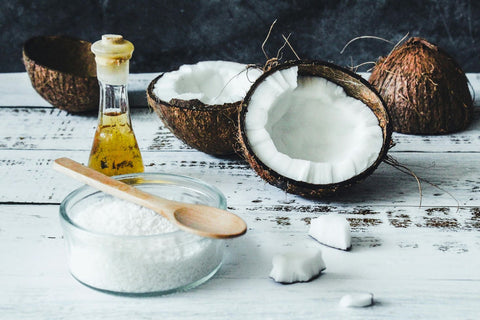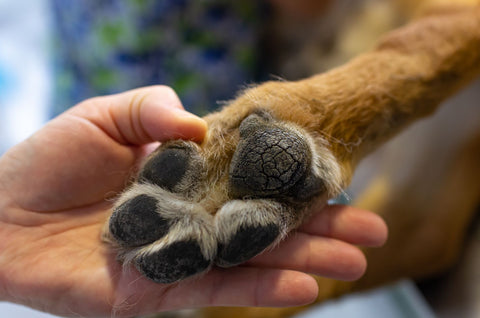Coconut oil is safe for a dog’s nose in small amounts. It moisturizes dry, cracked skin, has antimicrobial properties, and is commonly used to soothe irritation. Use virgin, unrefined oil and apply sparingly. Always consult a vet if your dog has allergies or chronic skin conditions.

Dogs rely heavily on their sense of smell, which puts constant pressure on the skin around their snout. That makes the area more prone to drying, cracking, or becoming irritated.
Before diving into the how and why, here’s a quick breakdown for pet parents searching for fast answers:
Coconut Oil for Your Dog’s Nose: At a Glance
-
Safe for Dogs: Virgin, unrefined coconut oil is safe if licked in small amounts.
-
Heals Dry, Cracked Skin: Soothes and softens rough patches within minutes of application.
-
Antimicrobial & Anti-inflammatory: Natural compounds help combat bacteria and reduce irritation.
-
Ideal for Sensitive Snouts: Gentle enough for daily use on brachycephalic breeds and allergy-prone dogs.
-
Better Than Human Balms: No perfumes, synthetic waxes, or harsh preservatives—just clean, pet-safe care.
-
Supports Long-Term Skin Health: Creates a protective barrier and promotes healing without clogging pores.
Why Your Dog’s Snout Is the Most Sensitive Spot
The skin on a dog’s nose is structurally different from other areas of their body. It is packed with nerve endings, blood vessels, and scent receptors, all working together to help them detect subtle environmental changes.
Because the nose stays exposed to the elements and plays a role in regulating body temperature, it is more vulnerable than other areas of the skin. This sensitivity makes the snout one of the first places where skin problems can show up.
Some of the most frequent issues pet owners notice include:
-
Dryness related to weather changes or sun exposure Cold air and low humidity pull moisture from the skin. In summer, prolonged sun exposure can trigger similar drying effects.
-
Cracks that may bleed or become infected: As dry skin worsens, the surface can split. These small cracks leave the nose open to bacteria and other irritants.
-
Thickening of the skin known as nasal hyperkeratosis: Often seen in older dogs, this condition causes hardened layers to form, sometimes resulting in a rough or crusty surface.
-
Irritation from licking or harsh products: Dogs that lick their noses frequently or are exposed to scented grooming products may develop red, inflamed skin.
-
Increased dryness in brachycephalic breeds like bulldogs: Flat-faced breeds tend to show symptoms more quickly. Their facial structure can trap moisture or irritants, which often leads to early dryness.
In some cases, skipping just one application of nose balm has led to visible dryness by the next morning. Consistency is often key to keeping the skin in balance.
Dog Breeds Especially Vulnerable to Cracked Noses
Some dogs are simply more prone to nose problems than others. Whether it’s due to facial structure, age, or sensitivity to environmental triggers, certain breeds tend to develop dry or cracked noses more often.
For these dogs, what might be a minor skin issue for another breed can quickly turn into something that needs attention.
-
Bulldogs and French Bulldogs: Their flattened faces can trap moisture around the nasal area, which often leads to crust buildup and dryness.
-
Boxers: This breed is known for having sensitive skin. Allergens in the environment or food often show up as dryness around the snout.
-
Labrador Retrievers: Labradors can develop a condition called Dudley Nose, where pigment fades and the skin becomes dry and fragile.
-
Pugs: The skin folds around their nose can trap dirt and bacteria, drying out the surface and sometimes leading to irritation.
-
German Shepherds: As they age, they are more likely to develop nasal hyperkeratosis, which makes the nose rough and thickened.
-
Chihuahuas and Dachshunds: These smaller breeds are often sensitive to artificial fragrances and ingredients found in grooming products, which can dry out the nose.
Coconut Oil: Natural Skin Soother for Dogs
Many dog owners hear about coconut oil and assume it is a trendy fix for everything, but it has a long history of use in skin care for a reason.
It works best when applied correctly and used for the right conditions.
For dogs with dry noses, it offers a simple, natural way to bring moisture back to the skin without synthetic chemicals or fragrances.
What sets coconut oil apart is not just what it contains but how those ingredients interact with the skin barrier. It is safe in small amounts, easy to apply, and absorbs quickly.
What It Is and How It’s Made
Coconut oil is extracted from the white flesh of mature coconuts. The highest quality versions are cold-pressed and unrefined, meaning they keep more of their original nutrients and fatty acids.
These fatty acids include lauric acid, capric acid, and caprylic acid, all of which are known for their moisturizing and antimicrobial properties.
Unlike refined oils that go through bleaching or deodorizing, unrefined coconut oil maintains a mild coconut scent and creamy texture.
It also avoids chemical stabilizers, which can be irritating for sensitive dogs.
How It Works on Dog Skin
Coconut oil acts as a lightweight barrier that keeps moisture in and harmful bacteria out.
When applied to the nose, it begins to soften rough patches within minutes. The skin around the snout is thinner and more exposed than other parts of the body, so hydration must come from a product that can sink in without causing irritation.
Coconut oil’s texture makes it easy to work into the skin without rubbing or pressure. It also contains natural anti-inflammatory compounds that can calm minor redness or irritation caused by weather, allergens, or grooming products.
Because the oil does not stay greasy for long, dogs are less likely to resist the application.
Why It’s Used in Pet Skincare
Coconut oil is safe if licked off in small amounts, which is a major reason why it is trusted for use on noses and paws. It offers a natural alternative to balms that contain synthetic waxes, perfumes, or preservatives.
Many owners apply it directly to dry areas or use it as a base for homemade balms.
Some even add small portions to food, although that should be done with care. Too much coconut oil can cause digestive problems like loose stool, especially if introduced too quickly.
When used in moderation, it supports healing without adding unnecessary ingredients to your dog’s routine.
Legend’s Creek Farm: The Skin Care Your Dog Would Choose
Every dog product that we make starts with the same principle: if it’s not safe for us, it’s not safe for our animals.
Our entire pet care line is handcrafted with cruelty-free practices, and we never use artificial preservatives, synthetic fragrances, or unnecessary fillers.
Every ingredient is chosen for a reason, and we never include anything that doesn’t serve a clear purpose in the formula. From herbal infusions to raw oils and butters, our goal is to create products that support skin health without causing irritation or adding stress to your dog’s care routine.
Nose Balm with Coconut Oil
Product Featured -> Nose Balm
A concentrated balm made with coconut oil, lanolin, calendula, and rosemary extract. Designed to stay in place and nourish deep into the skin.
Why dog owners love it:
-
Softens scabs and rough patches
-
Helps the skin hold moisture longer than plain oil
-
Safe if licked or rubbed during sleep
Unscented Goat Milk Soap
Product Featured -> Unscented Goat Milk Soap
A gentle, fragrance-free soap for dogs with sensitive or irritated skin. Made with goat milk, coconut oil, and moisturizing plant oils.
Why it works:
-
Leaves skin clean but never dry
-
Pairs well with balm for dogs prone to nose irritation
-
No added scent or colorants
Nose and Paw Bundle
Product Featured: Nose and Paw Bundle
A convenient kit featuring our coconut oil nose balm and paw balm containing a combination of natural oils. Both products are lick-proof and most dogs tolerate them well.
Why it's ideal for full coverage:
-
Treats multiple problem areas with one routine
-
Perfect for winter or dry climate use
-
Safe and effective for seasonal care
Application Tips: How to Moisturize Without a Tug-of-War
Applying balm to a dog’s nose can be simple if the timing is right and the method is gentle.
Rushing the process or using too much product usually backfires, especially with dogs that are sensitive to touch. The goal is to help the skin absorb the balm without triggering resistance or excessive licking. A calm environment and a steady hand make all the difference.
Start by picking a time when your dog is naturally relaxed.
Right after a walk or just before bed works well for most dogs. Their energy is lower, and they are more likely to stay still. Always begin with clean hands or a cotton swab to avoid introducing bacteria to the area.
A pea-sized amount is more than enough for most dogs. Apply it gently to the top and sides of the nose, without pressing too hard or dragging across the skin. If you notice product buildup, you are likely using too much.
To keep your dog from licking it off immediately, offer a distraction. A treat, a favorite chew, or a quiet toy can help them focus elsewhere while the balm sets in.
Many owners find success applying it during crate time or after meals, when dogs are naturally less active. Grooming routines or cuddle sessions also provide a calm window for application.
Some pet owners share that applying balm before a walk is especially effective. Being outside gives the dog new sights and smells to focus on, which naturally draws attention away from the nose.
The key is to make application part of a consistent routine that your dog associates with calm, comfort, and reward. That way, the balm stays where it belongs and has time to do its job.
When It’s Time to Call a Vet
Coconut oil can be a helpful part of your dog’s skincare routine, but it is not a cure for more serious conditions. If the dryness does not improve or the skin becomes more inflamed, it may be a sign of an underlying problem.
Some symptoms point to infections or immune-related conditions that need professional care. Waiting too long can make the issue harder to treat and more uncomfortable for your dog.
If any of the following signs appear, stop using home treatments and speak with your veterinarian.
-
Cracks that bleed or ooze, especially if they do not close or start to scab after a few days
-
Thick, black crust forming on the nose that remains hard or painful despite regular moisturizing
-
Repeated pawing at the nose or signs of discomfort like head-shaking or sneezing
-
Swelling, discoloration, or a strong odor coming from the nose area
-
Dryness that appears alongside appetite loss, low energy, or changes in normal behavior
A veterinarian can help determine if your dog is dealing with a condition like nasal hyperkeratosis or Discoid Lupus, both of which require specific care plans.
If you are unsure whether the symptoms are serious, it is always safer to have the area checked. Early diagnosis can make a big difference in both comfort and long-term recovery.
Coconut Oil Is a Simple Fix for a Snout That’s Seen Better Days
A dry or cracked nose may seem like a small issue, but it affects how your dog experiences their environment. Simple ingredients like coconut oil can make a noticeable difference when used the right way.
The key is choosing products that are made with pets in mind and tested for safety, especially around sensitive areas like the nose.
That is where Legend’s Creek Farm comes in with a dog-friendly collection. Every balm, soap, and salve is made with clean ingredients and real-world feedback from pet owners who care about quality.
Take a closer look at our full Pet Care Collection and find relief they will feel on day one.





